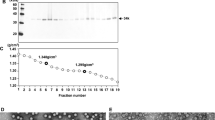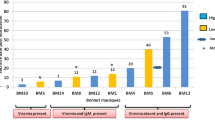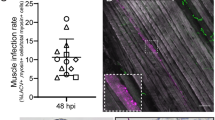Abstract
Bearcroft and Jamieson1 discovered a tumour on the face of a rhesus monkey imported from India to their laboratory in West Africa. In rapid succession, similar tumours appeared in other Asian monkeys housed in the same colony. Andrewes et al.2,3 demonstrated that the tumour was produced by a virus which probably belongs in the pox group. Investigators at the Roswell Park Memorial Institute4–9 classified this tumour as a histiocytoma and demonstrated (by electron microscopy) that the virus was indistinguishable from other viruses of the pox group, although no antigenic relationship to vaccinia or monkey pox virus could be demonstrated. The virus, when inoculated intravenously, produced lesions in the skin and internal organs of Asiatic monkeys, but monkeys imported from Africa appeared to be immune. The susceptibility of human beings to this virus was observed in a laboratory accident in which an injection needle containing Yaba virus suspension accidentally penetrated the skin of an investigator6.
This is a preview of subscription content, access via your institution
Access options
Subscribe to this journal
Receive 51 print issues and online access
$199.00 per year
only $3.90 per issue
Buy this article
- Purchase on Springer Link
- Instant access to full article PDF
Prices may be subject to local taxes which are calculated during checkout
Similar content being viewed by others
References
Bearcroft, W. G. C., and Jamieson, M. F., Nature, 182, 195 (1958).
Andrewes, C. H., Allison, A. C., Armstrong, J. A., Bearcroft, G., Niven, J. S. F., and Pereira, H. G., Acta Unio internat. contra cancrum, 15, 760 (1959).
Niven, J. S. F., Armstrong, J. A., Andrewes, C. H., Pereira, H. G., and Valentine, R. C., J. Path. and Bact., 81, 1 (1961).
Feltz, E. T., Proc. Amer. Assoc. Cancer Res., 3, 224 (1961).
Metzgar, R. S., Grace, jun., J. T., and Sproul, E. E., Ann. New York Acad. Sci., 101, 192 (1962).
Grace, jun., J. T., Mirand, E. A., Millian, S. J., and Metzgar, R. S., Fed. Proc., 21, 32 (1962).
Ambrus, J. L., Feltz, E. T., Grace, jun., J. T., and Owens, G., Nat. Cancer Inst. Monograph No. 10 : 447, (1963).
Sproul, E. E., Metzgar, R. S., and Grace, jun., J. T., Cancer Res., 23, 671 (1963).
Grace, jun., J. T., Owens, G., Feltz, E. T., Ausman, R., and Ambrus, J. L. (to be published).
Morgan, J. F., Morton, H. J., and Parker, R. C., Proc. Soc. Exp. Biol. and Med., 73, 1 (1950).
Author information
Authors and Affiliations
Rights and permissions
About this article
Cite this article
FELTZ, E. In vitro Culture of Yaba Virus-induced Tumour from Monkeys. Nature 202, 625–626 (1964). https://doi.org/10.1038/202625a0
Issue Date:
DOI: https://doi.org/10.1038/202625a0
Comments
By submitting a comment you agree to abide by our Terms and Community Guidelines. If you find something abusive or that does not comply with our terms or guidelines please flag it as inappropriate.



